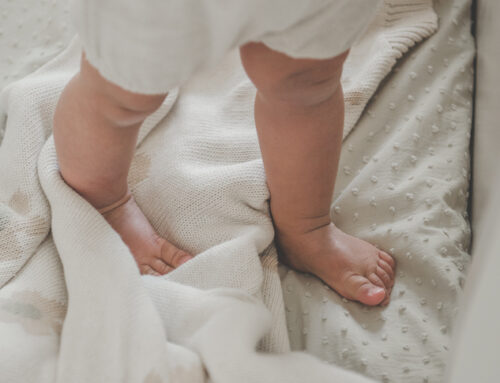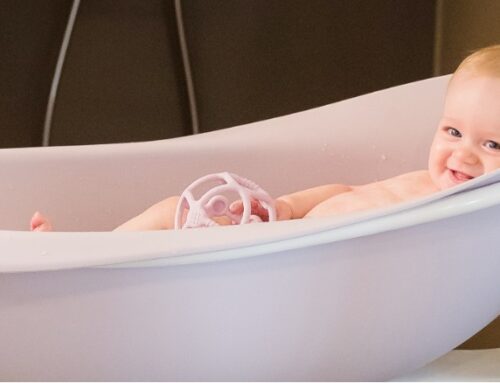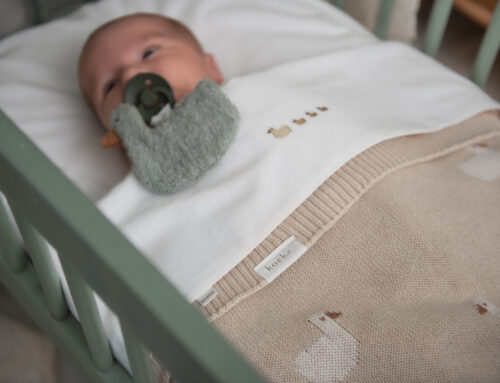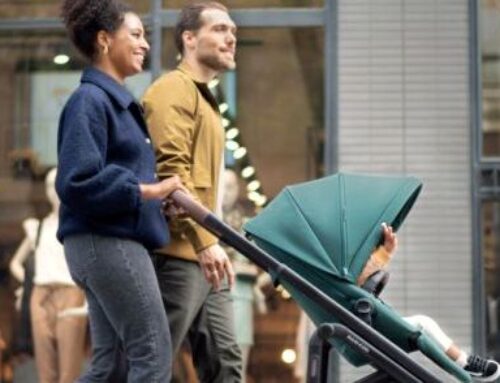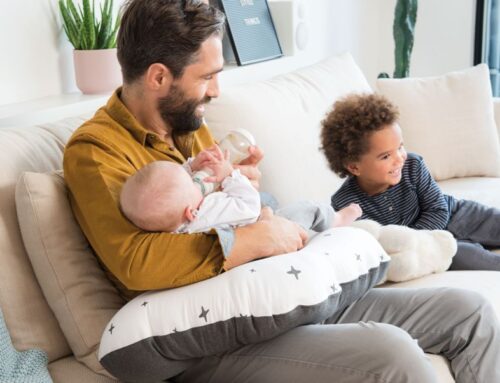What are popular baby carriers today? Are all baby carriers now ergonomic? What are the latest developments? We ask one of the most specialized babywearing specialists, Wendy Haisma.
Talking to an expert in carrying baby’s
Wendy is co-owner and trainer of ‘Zorgdragen Opleidingen.’ Since 2015, they have been offering courses on carrying a baby to healthcare professionals working with young children, such as paediatric physiotherapists and nurses. They also offer courses to people who want to become babywearing consultants but do not work in the care sector. She assisted in rewriting the parent-child relationship guideline for the Youth and Family Centre and speaks on carrying at home and abroad. In addition, since 2011, she has been a babywearing consultant in the province of Groningen and North Drenthe and, until recently, the owner of the webshop Ikdraag.nl. A real expert, therefore.
Has baby wearing changed much in the last ten years in terms of babywearing?
Wendy: ‘Certainly, the range of ergonomic carrying systems has grown enormously. Whereas ten years ago, baby carriers were ‘one size fits all,’ almost all can be adjusted nowadays. And the ‘toddler sling’ phenomenon was just emerging ten years ago. Meanwhile, baby carriers in larger sizes are readily available. There are also more options for the very youngest: not every parent is comfortable tying a baby sling, so it is very nice to have baby carriers that fit newborns or even premature babies. Of course, with the guidance of a specialized wearing consultant. In addition, parents find it easier to find information about carrying on Facebook groups and the wearing consultant is well established.’
What do you think of the range of baby carriers these days and the expensive, Instagram-worthy ones?
‘It is very nice that every parent can now find a system that suits their own taste and budget. But the price says nothing about the quality or ergonomics of a baby carrier. Making this product so expensive is not necessary, which is sometimes just a marketing strategy. The important thing is that the baby carrier fits both parent and child well. It is a pity if parents get the idea that they need to buy an expensive baby carrier to be able to carry properly because that is absolutely not the case. After extensive trying out, most parents choose the baby carrier most comfortable for them and their baby, which is usually an inexpensive to medium-priced sling. Some expensive baby carriers are not even of good quality: fabric going bald, buttons coming undone, and even seams coming undone!’
Is babywearing a trend or an established practice?
‘Carrying is quite common in the Netherlands. Or rather ‘reintroduced’, as carrying was the way to transport a child here, too, until a few centuries ago. A baby sling or carrier is now a standard part of a baby’s outfit, and carrying systems are readily available. The interest in carrying from the health care sector also says a lot about this: physiotherapists receive questions about it, and many health care centres employ paediatric nurses who are also babywearing consultants. The increased attention to the attachment relationship between parent and child has also contributed to this. Babywearing is, after all, a straightforward way of offering closeness to your baby.’
Research shows that educated women, in particular, want to carry their babies. Can you explain this?
Wendy: ‘During my consultations, I come across parents with all kinds of training, including practically trained parents. They are in the minority, indeed. I think the cost of a carrier system can be a barrier. This is why parents need to know that a good carrying system does not have to be expensive or new. Also, good information on wearing is not always readily available. To enjoy carrying, the carrying system must be comfortable. Otherwise, the sling or carrier will soon end up in the corner. A few simple tips can usually solve that, but you need to know where to find them. A babywearing consultation, babywearing consulting hours at health centres and midwives, and online babywearing groups can help.’
Can you say something about the ratio of purchase slings or carriers?
‘The baby carrier is still the most popular carrying system, and I think it will remain so. The convenience and speed appeal to many parents. Baby slings find their way to parents who enjoy learning to tie them. It is not difficult, but it takes some time to master. It is often the case that more slings follow once parents get hooked on the (woven) baby sling. Regarding purchase timing, we recommend you buy a carrier when the baby has arrived so you can try it out with the child.’
Do you see changes in the use of materials and designs of slings and carriers?
Wendy: ‘The biggest change is that most baby carriers now have an adjustable back section. Usually in height and width, sometimes in height or width. The nice thing about this is that the baby carrier can be adjusted to fit younger babies, but it also grows with them as they age. However, not every adjustable baby carrier can be used from birth. It is still important to check whether the size is correct. The toddler/preschool and big kid carrier are also real innovations. Ideal for parents who like to go on long walks and for children who are easily overexcited or cannot walk (far) on their own. You can also see that more and more baby carriers are made of woven sling fabric instead of canvas. The fabric of a baby sling is usually a little more supple and soft and therefore moulds itself nicely to the baby’s body. It also feels a bit more luxurious.’
Has there been any change concerning the recommended M posture? Do most carriers already comply with this?
“The M-posture is the optimal position for babies,’ Wendy answers. This involves squatting (knees higher than buttocks), lower legs dangling freely from the knee, and a slightly bent lower back. This position is very natural and supports good hip maturation. It is also a calming posture. Many baby carriers make this position possible. However, there are also baby carriers on the market in which the baby sits with its legs wide apart rather than in a squatting position because the back panel of the carrier is too firm or too rigid. Then the baby can spread its legs but cannot pull itself up properly. As a result, baby carriers in which the legs hang down are becoming increasingly rare. A good M posture involves more than just the legs; it also involves the hips, back and neck. In addition, the spine must have a natural curvature.’
Is carrying on the front still recommended?
‘No, for several reasons, that is a posture I do not recommend. It is more difficult for the baby to hold the M position, and the baby’s centre of gravity is not against the parent. This also makes it harder for parents to carry their babies. The baby easily hollows its back; the posture provokes stretching. In addition, when babies are carried facing away from their parents, they can’t shut themselves off from stimuli. This can lead to overstimulation. If babies want to see more of the world, I recommend hip carrying for younger babies, and older children often love back carrying. There are situations where forward carrying can be a good solution, for example, for children with a visual impairment or parents who use wheelchairs.
Can you tell us about the benefits of babywearing for the child?
‘Babies who are carried a lot cry up to 50% less. This is partly because a physiological reaction occurs when the baby is carried (on the arm or in a carrier system), which calms them down. A positive influence on bonding and parent-child interaction has been demonstrated. This is due to the skin contact and hearing the voice and heartbeat of the parent and the rocking. This leads to less uncertainty for the child. Carrying positively influences language development, as parents talk more to their baby while carrying. On average, mothers who carry breastfeed more often and for longer.’
Recent research
She continues: ‘And recent research shows that carrying upright in a baby carrier subtly stimulates the neck muscles. Incidentally, I do not recommend breastfeeding while wearing. There is then a high risk of choking and oxygen deficiency. There have been nasty accidents with this, where parents fed their babies in the best possible way while carrying them. After all, it is often promoted as an easy way to feed. That is why I think it is important that parents can get the right information.’
Are there recent studies and research figures available?
‘Certainly: Prof. Lela Rankin Williams has published several studies on carrying and bonding in 2020. Prof. Ann Bigelow has published research on the long-term effects of skin-to-skin contact on the mother-child relationship. The influence on language development was also investigated in 2018 (Mirault 2018). And a wonderful review article by Bernadette Berecz et al. has been published on the evolutionary origins of babywearing. A Japanese study shows that when babies are carried, their heart rate drops and blood pressure drops. You see a baby become calm. This is also seen in mammals and especially in primates. Humans are like primates; the point is that in an emergency, you have to be able to carry a baby in peace when there is danger.’
Are there any disadvantages besides practical advantages?
‘Carrying is often found convenient by parents because you have your hands free and can still offer closeness to your baby, and you can go out more easily (the bus or train, mountain walk, walk on the beach, up/downstairs). On the other hand, parents are sometimes afraid that their baby will not be able to sleep easily outside the baby carrier, and some babies do not sleep if they are not carried. The question is, of course, whether the baby does not sleep easily outside the baby carrier because he/she is used to being carried or whether the baby is carried because sleeping is not easy and when sleeping would not be easy without carrying either. Fortunately, day nurseries staff are usually skilled enough to deal with this. More and more employees of day nurseries also engage in babywearing. For them, having their hands free for once is also useful.’
Responding to changing needs for carrying
According to Wendy, parents need to adjust the time they spend carrying to their child’s development. She says: ‘A newborn usually benefits from being carried a lot, but as a child grows up, its needs change. For example, a 4-month-old baby also needs time and opportunity to learn to roll over and play with their feet and hands; a 6-month-old baby should be given a chance to crawl. I sometimes hear parents say that they think ‘the more we carry, the better it is for bonding’, but it is actually important, also for bonding, to look at the developmental phase and adjust the carrying accordingly.’
Trends in baby carriers
- Adjustable baby carriers, a model that grows with your child.
- Carriers for different target groups: premature babies, newborns, and toddlers.
- Use of new materials: breathable mesh and supple, woven fabrics.
- The reuse of baby carriers by recycling them.
Source: Baby-Wereld.nl



